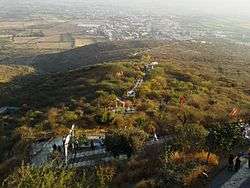Shatrunjaya
Shatrunjaya ("place of victory against inner enemies")[1] originally Pundarikgiri), also spelt Shetrunjaya are hills located by the city of Palitana, in Bhavnagar district, Gujarat, India. They are situated on the banks of the Shetrunji River at an elevation 164 feet (50 m) above sea level. These hills have similarities to other hills where Jain temples have been built in Bihar, Gwalior, Mount Abu and Girnar.[2]
| Shatrunjaya | |
|---|---|
 Climbing the stairs of Shatrunjaya Maha Tirth | |
| Highest point | |
| Elevation | 580 m (1,900 ft) archaeological survey of india |
| Coordinates | 21°28′6″N 71°48′0″E |
| Geography | |
 Shatrunjaya Location in Gujarat | |
| Location | Palitana, Bhavnagar district, Gujarat |
The Jain's sacred hill of Shatrunjaya have 865 temples atop itself.[3] The hills were sanctified when Rishabha, the first tirthankara of Jainism, gave his first sermon on the top of this hill .[4] The ancient history of the hills is also traced to Pundarika Swami, a chief Ganadhara[5] and grandson of Rishabha, who attained Nirvana/Moksha here. His shrine located opposite to the main Adinath temple, built by Son of Rishabha, Bharata.[6][7]
There are several alternate spellings, including Śatruñjaya, Satrunjaya, Shetrunja, and Shetrunjo. Shatrunjaya was also known as Pundarikgiri as Pundarik was said to have attained nirvana on this mountain.[8] Alternate names include Siddhakshetra or Siddhanchal as many thirtankaras have received enlightenment here.[9]
Etymology
Jains refer to their temples as derasaras. Shatrunjaya, the name for Mount Shatrunjaya where it is located, means a "place of victory" or "which conquers enemies".[1][10][11]
Geography

The Gulf of Khambhat is to the south of the Shatrunjaya Hills, Bhavnagar town is to its north, and a river flows between the two hills. Legend states that the hill is a part of the Girnar ranges.[12] A path along the ridge leads down to the Adipur valley, a distance of 13 kilometres (8.1 mi).[12] Palitana town is at the base of the foothills, 56 kilometres (35 mi) from Bhavanagar. The topography is rugged while the landscape is drought-affected.[1]
Culture
The hills are an ancient tirtha (religious pilgrimage site). The Palitana temples, a pilgrimage complex on both hills and their saddle, are reached by climbing approximately 3750 stone steps, which are carved into the mountain.[10][13] The climb is 3.5 kilometres (2.2 mi) from the base and takes approximately two hours.[14] The hills are closed to pilgrims for four months during the monsoon season. The pilgrimage is known as "Shri Shantrunjay Teerth Yatra". It occurs from the Poornima day (Full Moon Day) of Kartik month according to the Jain calendar (October–November as per the Gregorian calendar). Jains assemble at the foot of the hills to undertake the yatra (religious journey). During this yatra, considered a great event in the lifetime of a Jain, pilgrims circumambulate the Shatrunjaya hills covering a distance of 216 kilometres (134 mi) on foot, offering prayers.[4]
See also
References
- Arnett, Robert (15 July 2006). India Unveiled. Atman Press. pp. 164–. ISBN 978-0-9652900-4-3. Retrieved 17 December 2012.
- John Cort (21 January 2010). Framing the Jina:Narratives of Icons and Idols in Jain History: Narratives of Icons and Idols in Jain History. Oxford University Press. pp. 120–. ISBN 978-0-19-538502-1. Retrieved 17 December 2012.
- Melton, J. Gordon (13 September 2011). Religious Celebrations: An Encyclopedia of Holidays, Festivals, Solemn Observances, and Spiritual Commemorations: An Encyclopedia of Holidays, Festivals, Solemn Observances, and Spiritual Commemorations. ABC-CLIO. pp. 19–. ISBN 978-1-59884-205-0. Retrieved 21 December 2012.
- "Pilgrims flock Palitana for Kartik Poornima yatra". The Hindu. 2 November 2009. Retrieved 20 December 2012.
- "Jain Festivals - Chaitra Purnima" (PDF). Jain University. Retrieved 10 January 2013.
- Dr Linda Kay Davidson; David Martin Gitlitz (1 November 2002). Pilgrimage: From the Ganges to Graceland : An Encyclopedia. ABC-CLIO. pp. 419–. ISBN 978-1-57607-004-8. Retrieved 17 December 2012.
- "Glistening spires of Palitana temples". The Hindu. 4 April 2004. Retrieved 20 December 2012.
- Gopal, Krishna; Girota, Phal S. (2003). Fairs and Festivals of India: Chhattisgarh, Dadra and Nagar Haveli, Daman and Diu, Goa, Gujarat, Madhya Pradesh, Maharashtra. Gyan Publishing House. p. 172. Retrieved 17 December 2012.
- Deshpande 2005, pp. 418–419.
- "Palitana". Official website of Jain Heritage Centre. Retrieved 17 December 2012.
- "Murtipujakas, Jainism", Encyclopedia of World Religions (PHILTAR), University of Cambria Archived 13 October 2007 at the Wayback Machine
- Rough Guides (20 January 2011). The Rough Guide to India. Penguin. pp. 1216–. ISBN 978-1-4053-8849-8. Retrieved 17 December 2012.
- Brajesh Kumar (2003). Pilgrimage Centers Of India. Diamond Pocket Books (P) Ltd. pp. 157–. ISBN 978-81-7182-185-3. Retrieved 17 December 2012.
- Max T. Taylor; Max T. Taylor M.D. (28 July 2011). Many Lives, One Lifespan: An Autobiography. Xlibris Corporation. pp. 301–. ISBN 978-1-4628-8799-6. Retrieved 17 December 2012.
Bibliography
- Deshpande, Aruna (2005). India:Divine Destination. Palitana. Crest Publishing House. pp. 418–419. ISBN 81-242-0556-6.CS1 maint: ref=harv (link)